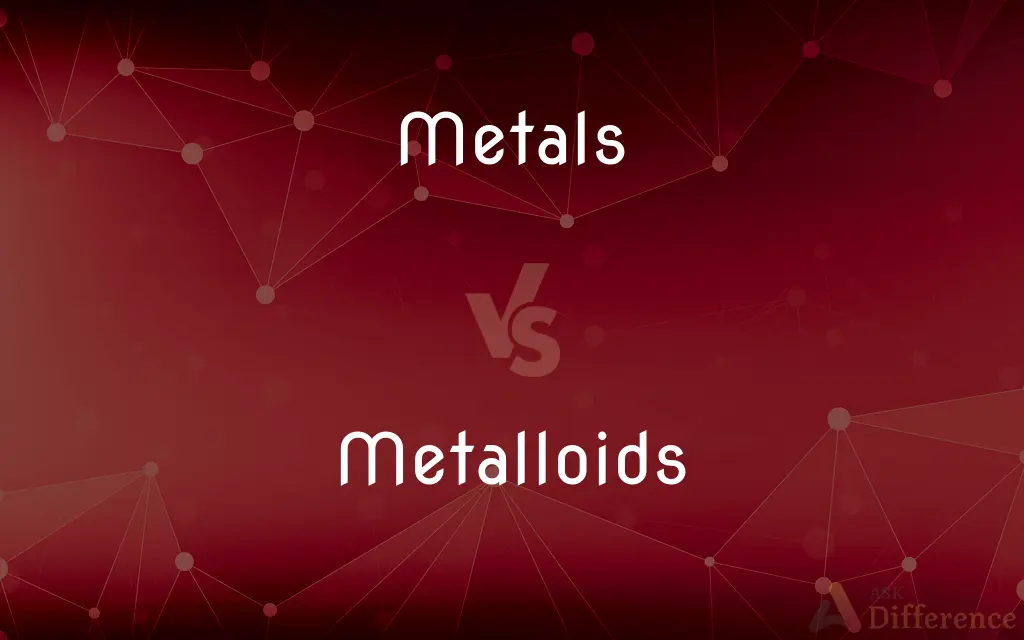Metals vs. Metalloids — What's the Difference?
By Tayyaba Rehman & Fiza Rafique — Published on February 22, 2024
Metals are lustrous, highly conductive, and malleable elements, essential in construction and manufacturing, whereas metalloids possess intermediate properties between metals and nonmetals, crucial for semiconductor and electronic applications.

Difference Between Metals and Metalloids
Table of Contents
ADVERTISEMENT
Key Differences
Metals, characterized by their shiny appearance, high conductivity for heat and electricity, and ability to be shaped (malleable) and drawn into wires (ductile), are foundational in numerous industries including construction, transportation, and electrical. They are typically found on the left side and in the center of the periodic table. Metalloids, or semimetals, are elements that exhibit properties intermediate between those of metals and nonmetals, making them uniquely valuable in the technology sector, especially in the production of semiconductors and various electronic devices. Metalloids are located along the metal-nonmetal dividing line in the periodic table.
The conductivity of metals and metalloids is a key difference. While metals are excellent conductors of electricity and heat, metalloids have variable electrical conductivity, which can be adjusted by altering temperature or adding impurities (doping), a property exploited in the production of semiconductors. This makes metalloids essential in the electronics industry, where precise control over electrical conductivity is necessary.
From a physical standpoint, metals are generally more dense, hard, and have higher melting points compared to metalloids, which can vary widely in their physical properties. Metals' malleability and ductility allow them to be formed into a wide variety of shapes and sizes, suited for structural materials and countless other applications. Metalloids, while not as malleable or ductile as metals, often possess a brittle consistency and are usually used in more specialized applications rather than for structural purposes.
Chemically, metals tend to lose electrons and form cations during reactions, a property that underlies their widespread use in batteries and electrical wiring. Metalloids, however, can either lose or gain electrons when reacting with other elements, depending on the specific conditions and reactants. This chemical versatility makes metalloids particularly useful in the chemical industry and in various types of sensors and detectors.
Environmental interactions also highlight differences between the two. Metals are prone to corrosion, a process where metals deteriorate due to reactions with their environment, necessitating various forms of protection like coatings or alloys. Metalloids, given their semi-conductive properties, play a crucial role in photovoltaic cells for solar energy, where they help convert sunlight into electrical energy, showcasing their importance in renewable energy technologies.
ADVERTISEMENT
Comparison Chart
Appearance
Shiny luster
Less lustrous than metals
Conductivity
High electrical and thermal
Variable, semiconductive
Malleability
Yes, easily shaped
Less malleable, often brittle
Density and Hardness
Generally high
Intermediate, varies widely
Melting Point
Generally high
Varies, generally lower than metals
Chemical Behavior
Lose electrons to form cations
Can lose or gain electrons
Uses
Construction, transportation, electrical
Semiconductors, electronics
Environmental Interaction
Prone to corrosion
Used in solar panels, sensors
Compare with Definitions
Metals
Elements that form cations in reactions.
Magnesium reacts with water, releasing hydrogen gas.
Metalloids
Less lustrous and often brittle, used in specialized applications.
Boron fibers are used in aerospace materials for their strength.
Metals
Prone to corrosion, requiring protective measures.
Aluminum is often anodized to prevent corrosion.
Metalloids
Possessing intermediate density and hardness.
Arsenic is used in lead alloys for improved strength.
Metals
Highly conductive elements used in wiring.
Copper wiring is essential in electrical circuits for its conductivity.
Metalloids
Elements with variable conductivity for electronics.
Silicon chips are the heart of modern electronic devices.
Metals
Malleable materials used in construction.
Steel beams are the backbone of skyscraper construction.
Metalloids
Can act as either electropositive or electronegative in reactions.
Germanium diodes are used for rectifying circuits.
Metals
Shiny elements with high melting points.
Iron is used in engines for its durability at high temperatures.
Metalloids
Crucial for renewable energy technologies.
Silicon is used in solar panels for converting sunlight into electricity.
Metals
An alloy of two or more metallic elements.
Metalloids
Having the appearance of a metal.
Metals
Plural of metal
Metalloids
A nonmetallic element, such as arsenic, that has some of the chemical properties of a metal. Most metalloids behave as semiconductors.
Metalloids
Plural of metalloid
Common Curiosities
Are there any metalloids that are more metal-like?
Yes, some metalloids like antimony and bismuth exhibit more metallic properties under certain conditions.
How are metals and metalloids used differently in industry?
Metals are widely used for their structural and conductive properties, while metalloids find specialized use in electronics, optics, and renewable energy.
Why are metalloids important in electronics?
Their adjustable electrical conductivity makes them essential for creating semiconductors, which are the foundation of all electronic devices.
Do metals or metalloids have higher melting points?
Metals generally have higher melting points, making them suitable for high-temperature applications.
Are metalloids used in batteries?
While less common than metals, certain metalloids are used in battery technologies to enhance performance and capacity.
What distinguishes metals from metalloids?
Metals are highly conductive and malleable, ideal for structural uses, while metalloids have variable conductivity and are crucial in semiconductor technology.
Can metalloids conduct electricity as well as metals?
No, metalloids have lower and variable conductivity, which can be precisely controlled, unlike the consistent high conductivity of metals.
Which are more abundant in nature, metals or metalloids?
Metals are more abundant and widely distributed in the Earth's crust compared to metalloids.
Can metalloids be used as catalysts in chemical reactions?
Yes, certain metalloids, such as boron and silicon, are used as catalysts in organic synthesis and industrial chemical processes due to their unique ability to influence chemical reactions without being consumed.
Can both metals and metalloids form alloys?
Primarily metals form alloys, but metalloids can be added to metals to improve their properties.
Why are metalloids preferred over metals in semiconductor devices?
Metalloids have semiconductive properties that can be precisely controlled by doping with impurities, making them ideal for semiconductor devices where the manipulation of electrical current is necessary. This control is not possible with metals, which have free and constant conductivity.
What is the significance of metalloids in biological systems?
While metalloids are less common in biological systems compared to metals, some, like silicon and selenium, play critical roles in human health and the structure of certain organisms. For instance, silicon is important for bone health, and selenium functions as a key component of enzymes with antioxidant properties.
How do protective coatings on metals prevent corrosion, and is there an equivalent for metalloids?
Protective coatings on metals, such as paint, galvanization, or anodization, prevent corrosion by isolating the metal surface from corrosive environments. For metalloids, their use in environments where corrosion is a concern is less common due to their different applications. However, when necessary, surface passivation or protective coatings can also be applied to metalloids to prevent degradation.
Why are metals typically more ductile than metalloids?
Metals have delocalized electrons that allow atoms to slide past each other without breaking bonds, making them malleable and ductile. Metalloids have more directional bonds, making their structures more rigid and brittle, limiting their ductility.
What role do metalloids play in the environment?
Metalloids play various roles, including in environmental sensors and as components in technologies for pollution control and renewable energy, like photovoltaic cells for solar power.
How does the occurrence of metals and metalloids in nature differ?
Metals are more commonly found in nature, often in ores that require extraction and refinement. Metalloids are less abundant and typically occur in more complex mineral forms, sometimes associated with metallic minerals, but generally in lower concentrations.
How do environmental interactions differ between metals and metalloids?
Metals are prone to corrosion, while metalloids are utilized in environmental technologies like solar energy conversion.
How do the electrical properties of metals and metalloids affect their uses in technology?
The high electrical conductivity of metals makes them indispensable for electrical wiring, circuitry, and electromechanical devices. The semiconductive properties of metalloids, which allow for controlled electrical conductivity, are fundamental to the operation of electronic devices, including computers, smartphones, and solar cells.
How does the reactivity of metals compare to metalloids?
Metals generally react by losing electrons to form positive ions, making them quite reactive, especially with acids. Metalloids have a more varied reactivity, capable of both losing and gaining electrons depending on the reaction, which makes their chemical behavior more complex and less predictable than that of metals.
What advancements in technology are being made with metalloids?
Advances with metalloids include developments in nanotechnology, where their unique properties at the nanoscale are exploited for electronics, energy storage (like batteries), and medical applications (such as drug delivery systems). Additionally, research into new semiconductor materials aims to improve the efficiency and capabilities of electronic devices and solar cells.
Share Your Discovery

Previous Comparison
APA Referencing vs. Harvard Referencing
Next Comparison
KH2PO4 vs. K2HPO4Author Spotlight
Written by
Tayyaba RehmanTayyaba Rehman is a distinguished writer, currently serving as a primary contributor to askdifference.com. As a researcher in semantics and etymology, Tayyaba's passion for the complexity of languages and their distinctions has found a perfect home on the platform. Tayyaba delves into the intricacies of language, distinguishing between commonly confused words and phrases, thereby providing clarity for readers worldwide.
Co-written by
Fiza RafiqueFiza Rafique is a skilled content writer at AskDifference.com, where she meticulously refines and enhances written pieces. Drawing from her vast editorial expertise, Fiza ensures clarity, accuracy, and precision in every article. Passionate about language, she continually seeks to elevate the quality of content for readers worldwide.










































